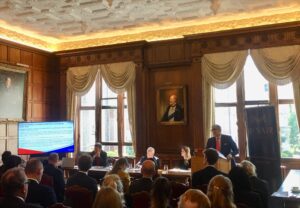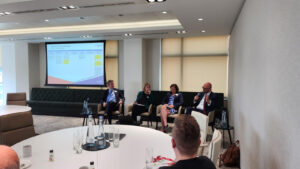Days 2 and 3 of the LIDW 2023 saw insightful discussions on three hot topics in international arbitration, i.e. corruption, diversity and efficiency. This post summarizes discussions held during two events: “Corruption in International Arbitration: Challenges and Approaches” held on Day 2, and “Increasing Diversity and Efficiency in the Resolution of Construction and Engineering Disputes” organized on Day 3.
Corruption in International Arbitration: Challenges and Approaches
The panel discussion on corruption in international arbitration chaired by The Rt Hon Sir Peter Gross explored some of the legal, evidential, and practical issues surrounding corruption in international arbitration. The panelists, Khawar Qureshi KC (McNair International), Harriet Chopra (Fladgate), and Andrew Maclay (McNair International) provided valuable insights into defining corruption, establishing its presence before arbitral tribunals, and enforcement of awards where corruption is involved.
Defining and Identifying Corruption
Khawar Qureshi KC first highlighted the troublesome nature of proving corruption in international commercial transactions. He noted that the first hurdle lies in defining corruption itself, followed by establishing its presence before an arbitral tribunal. He stated that further complexities could arise when determining the appropriate approach for enforcement of an award that involves issues of corruption.
 Mr Qureshi noted that English law or international law sources such as the Bribery Act in the UK and Deferred Prosecution Agreements provided guidance in defining corruption in the UK. However, achieving a universally accepted international definition of corruption still posed as a challenge.
Mr Qureshi noted that English law or international law sources such as the Bribery Act in the UK and Deferred Prosecution Agreements provided guidance in defining corruption in the UK. However, achieving a universally accepted international definition of corruption still posed as a challenge.
Mr Qureshi pointed out that corruption was increasingly raised in investment treaty disputes and that the standard of proof for corruption varied and remained somewhat unclear. His observations were that some arbitral tribunals have adopted the “clear and convincing evidence” standard (Lao Holdings N.V. v. Lao People’s Democratic Republic) whereas at least three arbitral tribunals have found that “circumstantial evidence” could be relied upon (Jan Oostergetel and Theodora Laurentius v. The Slovak Republic). He underscored why such a high standard of proof for corruption allegations existed, explaining how such allegations of corruption were raised “down the line”, often when there was a change in the political regime in a State or raised by State officials when their desired benefits were not received.
Andrew Maclay focused on the indicators to identify corruption. He observed that these could be found by (a) identifying the relevant legal standard of proof, (b) identifying the applicable criminal law, (c) finding evidence on corruption, (d) understanding the transaction, and (e) using red flags. He then pointed out various ways of obtaining evidence, including (a) disclosure requests through a Redfern Schedule, (b) through the criminal or insolvency powers available in a particular State, (c) whistleblowers, (d) confessions, and (e) data analytics and AI.
The Intersection of Corruption with Arbitration Proceedings
Mr Qureshi presented four scenarios in which corruption issues typically arise in international arbitration. Firstly, corruption could be pleaded upfront by the respondent as a jurisdictional challenge or, if unsuccessful, as a substantive claim. Secondly, corruption could be used as a bar to the recognition and enforcement of an arbitral award. Thirdly, sham arbitration proceedings could be employed as a cover for money laundering activities. Lastly, corruption could occur on the part of arbitrators themselves like in the case of Croatia v Slovenia (covered by the blog here) where parties have gone to great lengths to influence the outcome of a case.
On the question of whether arbitrators have a duty to raise questions regarding corruption when it is not specifically pleaded, Mr Qureshi stated that while some argue for a moral or legal obligation on the part of arbitrators to do so, there are concerns regarding its potential impact on proceedings such as challenges to appointment of arbitrators and challenges to the enforcement of an arbitral award. He concluded by reiterating how corruption is an important and live issue in international arbitration and an increasing feature of large-scale arbitration involving States or State entities.
Harriet Chopra addressed the approaches taken by the English, French, and Swiss courts in dealing with corruption issues in international arbitration. She focused particularly on the case of Alexander Brothers v. Alstom Transport SA, which concerned a challenge to an arbitration award at the stage of enforcement on the ground that the award would be against the public policy (due to allegations of corruption in the case) of the State where it was being enforced.
She noted that the English court interpreted the public policy ground narrowly and found merit in the estoppel arguments made by Alexander Brothers since Alstom had the chance to raise the same corruption allegation before the arbitral tribunal but had failed to do so.
The Paris Court of Appeal, on the other hand, took a maximalist approach, re-examining the evidence of corruption under the French public policy lens and annulling the award after it found “serious, precise and consistent” indications of corruption. The case eventually reached the French Supreme Court in 2021, which held that the Paris Court of Appeal had erred in reaching its conclusion on the indications of corruption, however, seemed to agree with the maximalist approach of re-examining evidence.
The Swiss courts adopted a non-interventionalist approach, finding that once the evidence of corruption was already examined, it was not open for re-examination at the enforcement stage.
While all courts reached similar decisions in the cases discussed, their reasons for doing so differed and Ms Chopra compared their approaches and implications. The non-interventionalist approach taken by the English and Swiss courts found in favor of the importance of finality against that of illegality. In contrast, the maximalist approach of the French courts displayed a willingness to revisit corruption allegations finding it to be a part of French public policy. She ended her presentation by raising the question of whether the French approach would encourage parties to strategically save allegations for post-award proceedings.
Increasing Diversity and Efficiency in the Resolution of Construction and Engineering Disputes – A New Slant for ESG?
The second panel explored how diversity and efficiency were dealt with in two significant sectors of international arbitration, namely construction and engineering. The panelists Emerson Holmes (Hogan Lovells), Sarah Hannaford KC (Keating Chambers), Rupert Sydenham (Hogan Lovells), and Mariel Dimsey (Hong Kong International Arbitration Center) shared insights on the significance of diversity in international arbitration and highlighted the challenges and potential solutions for improving efficiency in the resolution of construction and engineering disputes.
Diversity in International Arbitration
Emerson Holmes kicked off the discussion with the topic of diversity in international arbitration.
He mentioned the growing number of organizations that have recognized the importance of the issue and taken initiatives to address the concern. These included the ERA pledge and Arbitral Women, to name a few. Additionally, he noted how institutions such as the ICC had updated its model letter for parties and arbitrators to promote diversity in the selection of arbitrators.

He then invited contributions from the panelists by asking the broader question of why diversity was important. Commenting on the issue first, Mariel Dimsey noted that HKIAC as an institution was equally committed to diversity initiatives and had made several attempts themselves to promote diversity. She highlighted how diversity in the constitution of an arbitral tribunal would ensure that different perspectives were considered. In an international context, when different parties with different legal backgrounds are concerned, such diversity would ensure that all the users felt represented. Ultimately, the nature of arbitration as a mechanism for dispute resolution necessitated that its users felt represented. She added that there were other associated reasons, such as the role that diversity played to help in canceling out unconscious bias.
Sarah Hannaford KC noted that diversity was important to stay “up to date with the times”.
Rupert Sydenham shared his observations of clients being keen to see law firms present diversity in arbitration proceedings, and to see that the firms themselves were diverse. He added that this issue was important on a much bigger level and that at Hogan Lovells, they had been “making strides in improving this”, with 100% of the partners that were promoted in the last year at their London offices, being women.
Diversity in Tribunal and Expert Appointments
Holmes raised the question of diversity in the appointment of experts, specifically in the male-dominated construction and engineering sectors. Hannaford shared her experience, noting that while mainstream engineering still lacks female experts, there has been an increase in the presence of women experts in areas such as quantum and forensic expertise. She also acknowledged that the presence of female judges has significantly improved in the Technology and Construction Court (TCC) in the UK, but noted that the numbers in international arbitration still lagged behind. Parties’ choices and the extended timeframes of arbitrations were identified as reasons for this discrepancy.
Efficiency in Construction and Engineering Disputes
The panel also addressed the issue of efficiency in the resolution of construction and engineering disputes, considering concerns from clients about costs and lengthy proceedings. Mr. Sydenham emphasized the need for efficiency provisions to be explicitly incorporated into institutional rules, and for arbitrators to be willing to utilize these provisions without compromising due process. Ms. Dimsey discussed how the HKIAC Rules attempted to expedite the arbitration process, including the absence of a scrutiny process, the use of language to encourage timely awards (Article 31.2), and the appointment of less busy arbitrators. However, she acknowledged the general need for Institutional Rules to include more forceful sanctions to ensure arbitrators are efficient in issuing awards.
Transparency and communication emerged as important factors in improving efficiency. Mr. Holmes highlighted the frustration experienced by clients when procedural orders set clear timelines for proceedings including timelines for the evidentiary stage, but how arbitral proceedings went “into a black hole” at the close of proceedings until the issuance of an award. Ms. Dimsey recognized the responsibility of institutions to follow up with the arbitral tribunal and ease parties’ anxieties during this period. Ms. Hannaford drew a comparison with English courts, where judgments were typically delivered in weeks rather than months, and highlighted the potential for improvement for international arbitration process in this regard. Mr. Holmes proposed a practice for arbitrators to provide monthly updates when an award is delayed, emphasizing how significant the impact a potential award on markets was, while Ms. Hannaford suggested shortening expert reports to save time and costs, emphasizing the need for comprehensibility.
The takeaways from the session included the ways to improve efficiency through explicit provisions, timely awards, transparency, and effective communication, the importance of enhancing diversity to bring different perspectives to the table, thus, improving the overall satisfaction that all users felt through the process of international arbitration.
________________________
To make sure you do not miss out on regular updates from the Kluwer Arbitration Blog, please subscribe here. To submit a proposal for a blog post, please consult our Editorial Guidelines.


